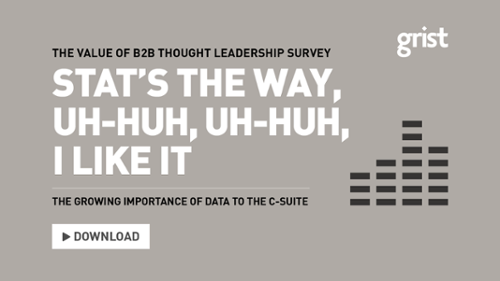With the opportunity to canvass business leaders around the world, we naturally asked what inspires trust in thought leadership – what it is about a piece of content that really engages them. Unsurprisingly, quality analysis is highly regarded (60%). Strikingly, though, the number of responses is the least important attribute (39%). This dispels the myth that, when it comes to survey sample, size matters.
The sample size question
The appreciation of quality over quantity is perhaps because, although data is important, it must have context to hit the mark. There is a danger of data overload in modern marketing – and not enough in-depth analysis.
However, the question of sample size can be a big concern for some people – they think they need to survey thousands of people and that will exceed their budget. This need not be the case in B2B surveys.
In B2C surveys you do need a big sample as you’re often looking at an entire country’s population. However, in B2B, you’ve already narrowed down your niche, which means your sample size can be smaller while retaining statistical validity.
You just need to keep in mind how you want to segment. If you want to cover several markets, verticals and countries, then you will naturally need to survey more people to ensure the individual segments retain statistical robustness.
The recommended minimum number of respondents for B2B surveys is 100 respondents per segment or audience group, which will give you a figure of +/- 4% at 95% confidence. This may sound complex, but it should provide confidence that the survey has covered all bases. The greater the number of respondents, the higher the confidence level. It's worth noting that confidence levels never reach 100% in sample-based surveys because of statistical error.
Boosting confidence levels by increasing the sample size can require thousands of pounds of investment. But for a gain of just 2-4% points in confidence, for a B2B survey, it is rarely worth it. The reason B2C surveys go wider is so they can narrow that gap to a 99% confidence ratio and make sound product-based and market-entry decisions.
Also, consideration needs to be made for media publications. Some are so set in their ways that they will only pick up and distribute reports with at least 500 respondents because they deem them more credible. Maximising ROI in your research is a delicate balance of minimising investment wastage in an unnecessarily large sample size, while ensuring maximum media coverage.
Analyse this
While sample size loses importance, statistical analysis does not. When asked their preferred mix of thought leadership – qualitative only, quantitative only or a mix – there was a fairly even split globally: 39% said qualitative, 34% said quantitative and 27% said both.
There is a leaning towards data (ie quantitative) in both the US (37%) and Asia Pacific (37%), while Europe favours interview-based (ie qualitative) research (43%).
Whatever research format you opt for, one thing is clear: you must ensure your analysis is sound and informative, especially if you’re talking to a US-based audience (65%). The data source is also important (59% globally) and the reputation of the research company less so (48%).
Whether you’re thinking globally or regionally, this means you don’t have to shell out big bucks for a world leader. As long as the survey design, methodology and analysis are sound, you can get statistically significant and robust research-driven thought leadership from a smaller research firm that may be able to spend longer with both you and respondents.
Quality over quantity
It’s worth noting qualitative research did come out on top in this survey, although not by much. This is perhaps because, although infographics are great, they must have context. As mentioned, data is all well and good, but too much, and without in-depth analysis, it can miss the mark.
Qualitative research helps increase the quality of analysis; it shows clearly what your peers think, not just which button they pushed, and can bring out insights that may not be obvious with pure data. By putting quantitative and qualitative research together you’re getting the best of both worlds.
Surveys tend to cost more as the number of people you speak to increases, so the fact ‘quantity of responses’ sits at the bottom of the trust barometer is good news. You don’t have to be a big gun with a big budget to deliver a survey-based thought leadership programme; we all have the chance to own an area.
For more insights, download the full report: The Value of Thought Leadership: The Growing Importance of Data.



